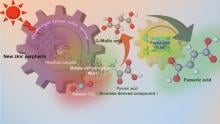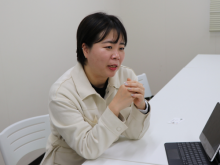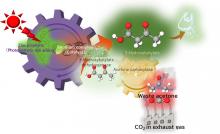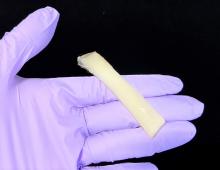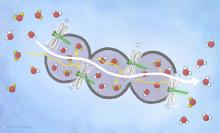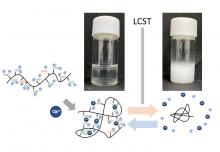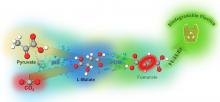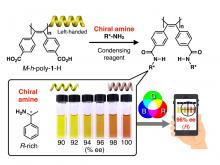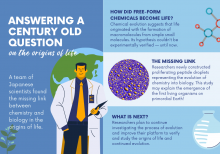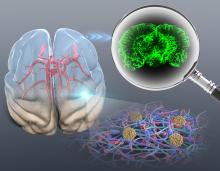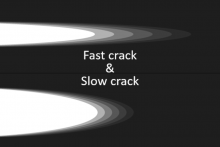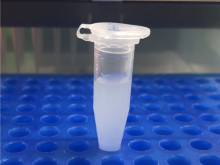Chemistry Polymer chemistry
News
14 Feb 2024
An innovative and more efficient way to produce fumaric acid that not only reduces carbon dioxide emissions, but also reuses waste resources to make biodegradable plastics
08 Sep 2023
Capturing carbon dioxide, Shells go nuclear, Worms surf electric fields, Brain repair & Creating matter from light. Plus from our blog: Monitoring research for further impact. Read all in the latest Editor's Choice.
02 Aug 2023
Soft metal-organic polymer networks can adsorb selected molecules from gas mixtures by opening pores when the molecules bind.
05 Apr 2023
We sat down with Dr. Ji Ha Lee to get to know her and her work on developing recyclable and degradable gels that can replace plastics as well as nanogels that can help with targeted drug delivery.
29 Mar 2023
Osaka Metropolitan University scientists have developed a process using artificial photosynthesis to successfully convert more than 60% of waste acetone into 3-hydroxybutyrate, a material used to manufacture biodegradable plastic. The results were obtained using low-concentration CO2, equivalent to exhaust gas, and powered by light equivalent to sunlight for 24 hours. The researchers expect that this innovative way of producing biodegradable plastic could not only reduce CO2 emissions but also provide a way of reusing laboratory and industrial waste acetone.
17 Feb 2023
Tree rings forecast extreme weather in central Asia, Squid 🦑and chemistry make versatile hydrogels, James Webb telescope reveals the earliest galaxies & Reducing negative effects of screen time. Read all in the latest Editor's Choice. Plus our latest journalist resource "Experts for Media: Antimicrobial Resistance "🦠.
06 Feb 2023
Researchers from Osaka University expanded the synthetic toolkit for preparing valuable chemical precursors from renewable feedstocks. They used microwave irradiation to dramatically improve the selectivity of the formose reaction, forming a simple six- and seven-carbon mixture that can be readily purified. These findings will help the chemicals industry minimize the use of fossil resources and improve the sustainability of manufacturing processes.
24 Jan 2023
Osaka Metropolitan University scientists have succeeded in synthesizing fumaric acid, a raw material for plastics, from CO2 powered by solar energy—for the first time. Typically, fumaric acid is synthesized from petroleum as a raw material to make polybutylene succinate, a biodegradable plastic, but this research shows that it can be synthesized from CO2 and biomass-derived compounds using renewable energy.
20 Jan 2023
The natural abilities of squid tissues and the creativity of chemists combine to take hydrogel research in new directions.
15 Dec 2022
Understanding how bats tolerate viral infections, Material separates water from...water, The virtual sense of touch polished to next level and COVID-19 negatively impacted early-careers and female researchers. Read all in the December's Editor's Choice.
09 Nov 2022
A flipping action in a porous material facilitates the passage of normal water to separate it out from heavy water.
14 Oct 2022
Osaka Metropolitan University scientists have created a novel thermoresponsive polymer by adding divalent cations to polymers and water solvents. They also succeeded in controlling thermoresponsive properties by changing the type and mixing ratio of ionic species. This new polymer type is expected to be applied as an analytical reagent for ion-sensing devices and as a material for drug delivery systems.
22 Aug 2022
Osaka Metropolitan University researchers have successfully synthesized fumarate (fumaric acid), a raw material for unsaturated polyester resin, by combining carbon dioxide (CO2) with pyruvate (derived from biomass), using two biocatalysts: malate dehydrogenase and fumarase. Fumarate is currently used to make biodegradable plastic like polybutylene succinate from petroleum. However, this research has enabled the synthesis of fumarate without petroleum, consuming only CO2 and biomass-derived pyruvate.
18 Jun 2022
The molecule is unusual and has ‘great potential’ in catalysis, conduction and other applications.
16 May 2022
Researchers from the Osaka Metropolitan University Graduate School of Engineering have successfully developed a new technique allowing them to observe gas molecules packing into metal-organic frameworks (MOF) using infrared spectroscopy. Their innovation was to measure polarized light absorption of guest molecules in a MOF film to deduce molecule alignment using this common piece of lab equipment. This method is the first to show guest alignment and does so in real-time, while using an accessible and easily adoptable experimental setup. A short video (4 min) recreating their spectrometer modifications can be found in the Reference section.
28 Sep 2021
Researchers at Kanazawa University report in Science Advances a new method for distinguishing between enantiomers, molecules that are mirror images of each other. The procedure, relevant for the pharmaceutical industry, involves the chemical reaction of target enantiomers with color indicator compounds consisting of one-handed helical polymers, leading to solutions showing different colors in specific solvents between the enantiomers.
27 Sep 2021
The missing link isn’t a not-yet-discovered fossil, after all. It’s a tiny, self-replicating globule called a coacervate droplet, developed by two researchers in Japan to represent the evolution of chemistry into biology.
14 Sep 2021
When it comes to cancer, clarity is key. The ability to visualize cancerous tumors and metastatic tissue three dimensionally (3D) can help clinicians diagnose the precise type and stage of cancer, while also informing the best treatment methods. To obtain an even clearer tissue for imaging, a research team based in Japan has tested the effectiveness of specialized hydrogels. Acting as a 3D molecular network, these hydrogels can rapidly remove fats from tissues, which are a factor in tissue opacification, without losing their structure. The material is used in several biomedical devices, including contact lenses.
30 Jul 2021
Researchers from The University of Tokyo Institute of Industrial Science develop an experimentally supported mathematical model that defines the velocity jump mechanism in crack propagation
30 Jul 2021
Testing a large library of compounds reveals an easy-to-make lipid that can carry genetic code into the lung to treat disease.
30 Jun 2021
Researchers from The University of Tokyo Institute of Industrial Science and Fudan University experimentally interrogate a phenomenon that bridges diverse fields of science and engineering
09 Dec 2020
Researchers at Hiroshima University in Japan have blended together various polymer and molecular semiconductors as photo-absorbers to create a solar cell with increased power efficiencies and electricity generation.
27 Jul 2020
Hokkaido University researchers have found a soft and wet material that can memorize, retrieve, and forget information, much like the human brain. They report their findings in the journal Proceedings of the National Academy of Sciences (PNAS).

03 Apr 2019
Chemists use free radicals to produce polymers strong enough to encapsulate drugs while remaining degradable.
Events
Sorry, nothing coming up for this discipline
Researchers
Professor Alex Jen Kwan-yue is Chair Professor of Materials Science and Director of the Hong Kong Institute for Clean Energy at the City University of Hong Kong (CityU). His expertise includes the use of molecular engineering and self-assembly for hybrid materials.
Dr Yuichi Ohya’s research fields are functional polymers and biomaterials, especially biodegradable polymers and drug delivery systems.
A Tenured Professor at the Institute of Space Technology (Pakistan), Dr. Shabbir is working on Polymer based Nanomaterials for water treatment, food safety, nano-drug delivery systems, solar cells and carbon dioxide capture.
Giants in history
Sorry, nothing coming up for this discipline



